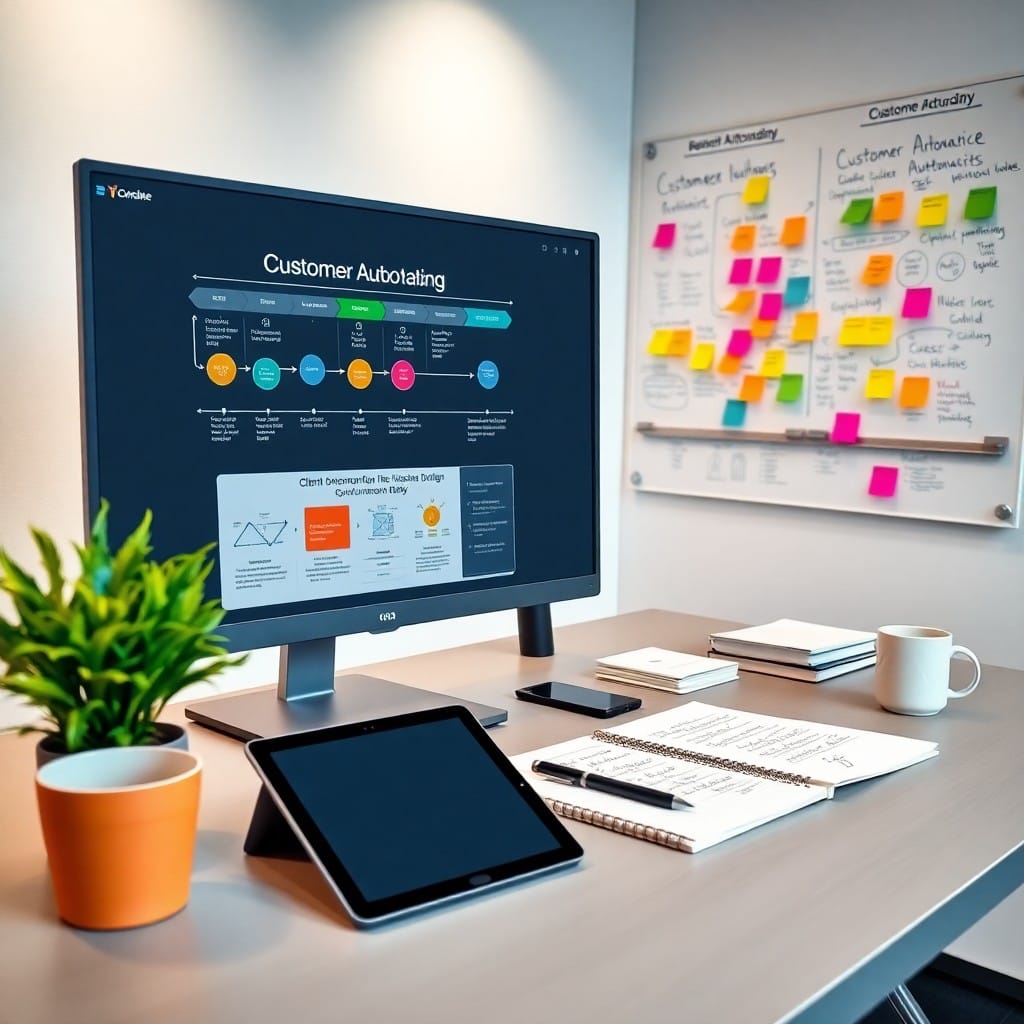Automate Client Onboarding: Customer Automation Guide

Automate Client Onboarding: A Comprehensive Guide to Customer Onboarding Automation
In today's competitive market, the efficiency of the client onboarding process can significantly impact customer satisfaction and retention. As businesses seek to enhance their onboarding experience, the power of automation has emerged as a critical factor. This comprehensive guide aims to explore the intricacies of automating client onboarding, providing insights into the processes, tools, and best practices necessary for creating a seamless onboarding experience that fosters long-term customer relationships.
What is the Client Onboarding Process and Why is Automation Important?
Understanding the Client Onboarding Process
The client onboarding process is a series of steps that a company undertakes to integrate new clients into its services or products. This process typically begins with the initial contact and extends through various stages, including client intake forms, information gathering, and setting expectations regarding the product or service. A well-defined onboarding journey not only clarifies the client's needs but also builds a foundation for a successful relationship. By understanding the nuances of the onboarding process, businesses can identify areas that require improvement and leverage automation to enhance efficiency.
The Role of Automation in Client Onboarding
Automation plays a transformative role in streamlining the client onboarding process. By utilizing automation tools, businesses can automate repetitive tasks such as data entry, document management, and communication. Automated workflows can significantly reduce the time and effort required to onboard a new client, enabling staff members to focus on more strategic activities that enhance the customer experience. Additionally, automation ensures consistency in the onboarding experience, minimizing the risk of errors that can arise from manual processes.
Leading AI Automation Agency
Transform Your Business with AI-Powered Automation Solutions
Join industry leaders who have achieved up to 300% ROI through our intelligent automation strategies. Our AI automation experts will help streamline your operations, reduce costs, and drive unprecedented growth.
Benefits of Streamlining the Onboarding Experience
Streamlining the client onboarding experience through automation brings numerous benefits. First and foremost, it improves operational efficiency, allowing businesses to onboard clients more quickly and effectively. A seamless onboarding experience also enhances customer satisfaction, as clients appreciate a straightforward and hassle-free integration into the company's services. Furthermore, effective onboarding can lead to higher customer retention rates, as clients who feel valued and supported are more likely to remain loyal to the brand. By embracing client onboarding automation, companies can create a positive first impression that sets the stage for a successful long-term relationship.
How to Automate Your Client Onboarding Process Effectively?
Choosing the Right Customer Onboarding Tool
Selecting the appropriate onboarding software is critical to automating the client onboarding process effectively. Businesses should evaluate various automation tools based on features such as ease of use, integration capabilities with existing CRM systems, and scalability. An ideal onboarding tool should facilitate automated workflows, provide customizable client intake forms, and offer analytics to measure onboarding success. By carefully choosing the right customer onboarding tool, organizations can ensure a smooth transition into automation and improve overall efficiency in their onboarding processes.
Setting Up Automated Workflows for Client Onboarding
Once the right onboarding software has been chosen, the next step involves setting up automated workflows for client onboarding. This process includes defining the specific steps that need to be taken during the onboarding journey, such as sending welcome emails, scheduling introductory meetings, and collecting necessary client information. By automating these tasks, businesses can create an organized and efficient onboarding workflow that minimizes manual intervention. Furthermore, automated reminders and notifications can help keep both clients and team members informed at every stage of the onboarding process.
Integrating CRM Systems for Efficient Automation
Integrating CRM systems with onboarding automation tools is essential for effective client onboarding. A well-integrated system allows for seamless data transfer between platforms, ensuring that client information is updated in real-time and accessible to all relevant team members. This integration not only enhances the accuracy of data entry but also improves collaboration among departments involved in the onboarding process. By leveraging the capabilities of CRM systems, businesses can streamline client onboarding and create a more cohesive customer experience.
What are the Best Practices for Client Onboarding Automation?
Creating a Seamless Onboarding Experience
To achieve a seamless onboarding experience, businesses should focus on clear communication and transparency throughout the client onboarding journey. Providing clients with a structured onboarding plan, including timelines and milestones, helps to set expectations and fosters trust. Additionally, personalizing the onboarding process based on individual client needs can enhance engagement and satisfaction. By adopting these best practices, organizations can ensure that clients feel supported and valued from the very beginning of their relationship.
Utilizing Data Entry Automation to Improve Efficiency
Data entry automation is a cornerstone of client onboarding automation. By automating the collection and processing of client information, businesses can eliminate the risk of errors that often accompany manual data entry. Automated data capture tools can extract information from client intake forms and populate databases without requiring human intervention. This efficiency not only saves time but also enhances the accuracy of client records, ensuring that the onboarding process is based on reliable information.
Monitoring and Improving the Onboarding Automation Workflow
Continuous improvement is vital for maintaining an effective onboarding automation workflow. Businesses should regularly monitor key metrics, such as onboarding completion rates and client satisfaction scores, to assess the effectiveness of their automated onboarding processes. Gathering feedback from clients can also provide valuable insights into areas for enhancement. By implementing iterative improvements based on performance data and client feedback, organizations can refine their client onboarding automation and ensure a consistently high-quality onboarding experience.
How to Streamline Customer Onboarding for Better Retention?
Identifying Key Metrics for Customer Retention
To streamline customer onboarding for better retention, it is essential to identify key metrics that correlate with customer satisfaction and loyalty. Metrics such as the time taken to complete onboarding, client engagement levels during the onboarding process, and post-onboarding satisfaction scores can provide insights into the effectiveness of the onboarding journey. By analyzing these metrics, businesses can pinpoint areas for improvement and adapt their onboarding strategies to enhance customer retention.
Personalizing the Onboarding Experience
Personalization is a powerful tool in the client onboarding process. By tailoring the onboarding experience to meet the specific needs and preferences of individual clients, businesses can foster a deeper connection and enhance overall satisfaction. This can be achieved through customized onboarding plans, targeted communication, and personalized support. By making clients feel valued and understood, organizations can significantly improve customer retention rates.
Feedback Loops in the Customer Onboarding Process
Implementing feedback loops during the customer onboarding process is crucial for continuous improvement. Regularly soliciting feedback from clients at various stages of the onboarding journey allows businesses to gather insights into their experiences and identify potential pain points. By actively addressing client concerns and incorporating their suggestions into the onboarding process, organizations can create a more responsive and adaptive onboarding experience that enhances customer loyalty and retention.
What Challenges Might You Face When Automating Client Onboarding?
Common Pitfalls in Client Onboarding Automation
While automating client onboarding offers numerous benefits, organizations may encounter common pitfalls if not approached strategically. Challenges such as inadequate training for staff, lack of clarity in processes, and resistance to change can hinder the successful implementation of onboarding automation. Businesses must proactively address these challenges by providing adequate training, clearly defining workflows, and ensuring that all team members understand the value of automation in enhancing the client onboarding experience.
How to Overcome Resistance to Change
Overcoming resistance to change is essential for successful client onboarding automation. To facilitate this transition, organizations should communicate the benefits of automation clearly to all stakeholders. Demonstrating how automation can alleviate workload, improve efficiency, and enhance customer satisfaction can help garner support from team members. Additionally, involving employees in the decision-making process and addressing their concerns can foster a culture of acceptance and adaptability.
Ensuring Data Security During the Automation Process
As businesses embrace automation in the client onboarding process, ensuring data security must remain a top priority. Automated onboarding processes often involve the collection and storage of sensitive client information, making it crucial to implement robust security measures. Organizations should utilize encryption, access controls, and regular audits to safeguard client data. By prioritizing data security, businesses can build trust with clients and protect themselves against potential breaches that could compromise the onboarding experience.
Q: What is customer onboarding automation?
A: Customer onboarding automation refers to the use of technology and software to streamline and enhance the process of integrating new customers into a service or product. This involves automating onboarding tasks, data collection, and communication to ensure a smooth transition for new customers.
Q: Why should businesses automate customer onboarding?
A: There are several reasons to automate client onboarding, including reducing manual work, minimizing errors, increasing efficiency, and providing a consistent experience for new customers. Automation can also help in collecting customer feedback throughout the onboarding process, which can be utilized to optimize the overall experience.
Q: How can I automate the client onboarding process?
A: To automate the client onboarding process, you can utilize automation software and tools like Zapier to create automated workflows that handle various onboarding tasks. This includes sending welcome emails, scheduling meetings, and managing document submissions, thereby reducing bottlenecks in the process.
Q: What are the benefits of automating customer onboarding?
A: Automating customer onboarding provides numerous benefits, such as improved efficiency, enhanced customer experience, faster processing times, and the ability to collect customer data more effectively. These advantages contribute to achieving customer onboarding goals and fostering long-term relationships with new customers.
Q: What types of onboarding tasks can be automated?
A: Onboarding tasks that can be automated include sending introductory emails, gathering necessary documents, scheduling training sessions, and providing access to resources. By automating these tasks, businesses can ensure a more streamlined onboarding flow.
Q: How does customer feedback play a role in onboarding automation?
A: Customer feedback is crucial throughout the onboarding process as it helps businesses identify areas for improvement. By collecting customer feedback during onboarding, companies can optimize their processes and ensure that new customers feel supported and satisfied.
Q: What tools are recommended for automating customer onboarding?
A: Recommended tools for automating customer onboarding include automation software like Zapier, which can integrate various applications, and other automated tools designed specifically for onboarding processes. These tools help streamline workflows and enhance the overall customer experience.
Q: How can I create an effective onboarding process using automation?
A: To create an effective onboarding process, you should first map out the onboarding flows and identify repetitive tasks that can be automated. Implementing automation software allows you to handle these tasks efficiently while focusing on personalizing the experience for new customers.
Q: What are the challenges of automating customer onboarding?
A: Challenges of automating customer onboarding may include the initial setup of automation systems, ensuring data accuracy, and maintaining a personal touch in customer interactions. It is essential to address these challenges to successfully harness the power of automation.



